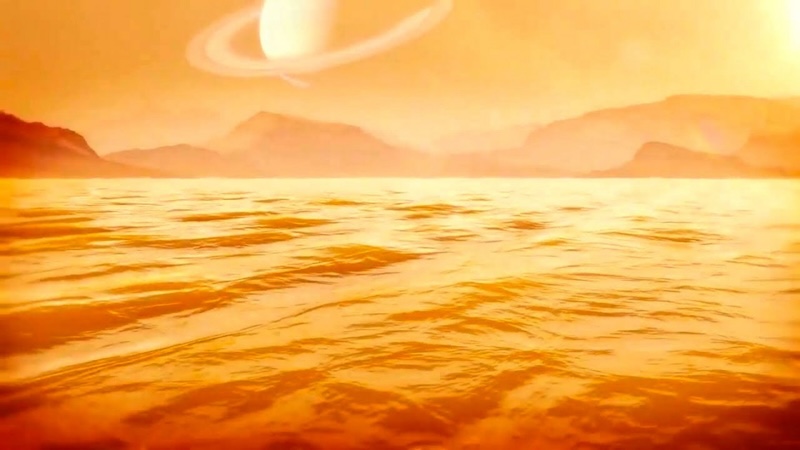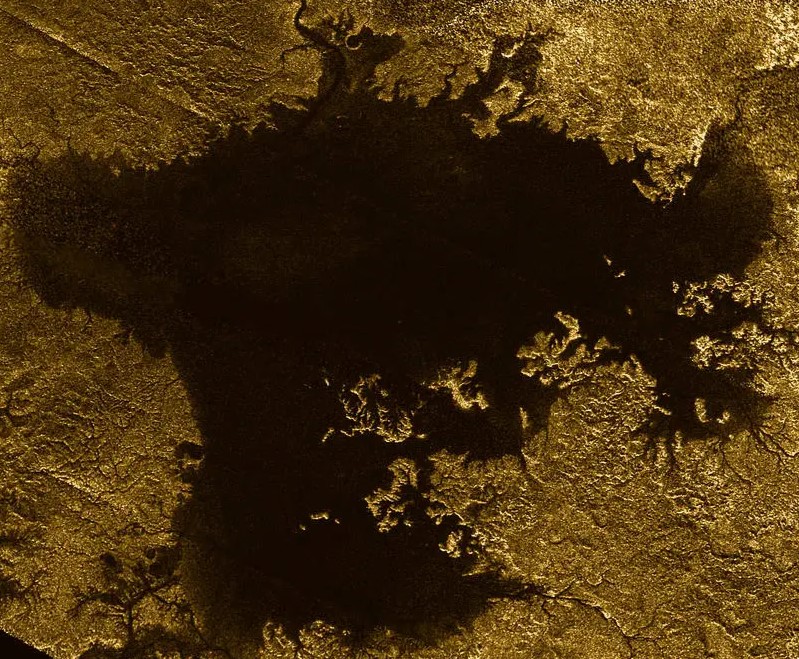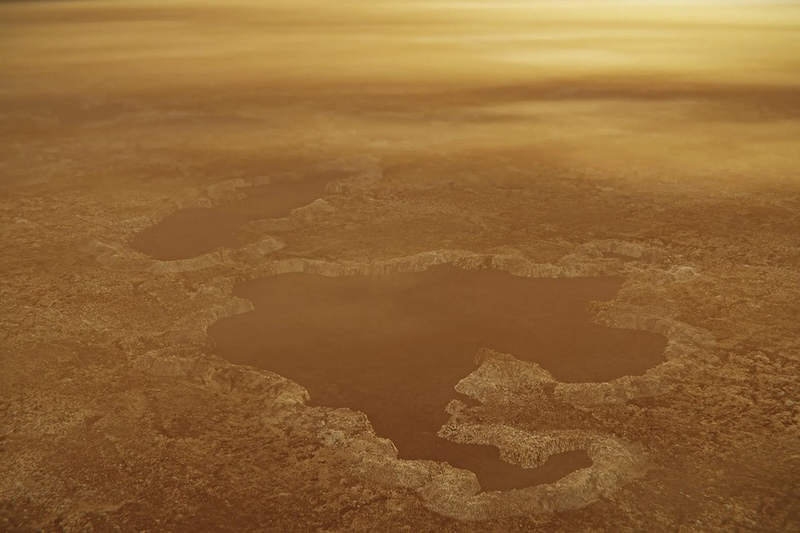
- Liquid methane and ethane, not water, make up the liquid in Titan’s seas and smaller lakes. Temperatures on this large moon of Saturn – in the outer solar system – are too cold for liquid water. NASA’s Cassini spacecraft first saw Titan’s seas and lakes in 2007.
- The shorelines of Titan’s seas are most likely created by waves, just as on Earth, according to new research.
- The researchers tested three different possible computer models. The wave scenario fit the data best for all of Titan’s largest seas.
Would shorelines of Titan’s seas remind us of home?
Much like Earth, Saturn’s large moon Titan has rivers, lakes and seas. Although they are composed of liquid methane and ethane instead of water, these bodies of liquid look – in spacecraft images – like their earthly counterparts, especially when sunlight is glinting off their surfaces. And scientists have wondered, how similar might they be? For example, do Titan’s seas, or even smaller lakes, have waves? If so, do the waves erode Titan’s coastlines as waves do on our planet? On June 19, 2024, scientists at the Massachusetts Institute of Technology (MIT) and the U.S. Geological Survey said new simulations suggest waves do help shape Titan’s seas and lakes.
The researchers published their peer-reviewed findings in Science Advances on June 19, 2024.
Titan’s seas and lakes
Scientists had long speculated there might be seas on Titan, based on what they knew about its climate and other factors. And NASA’s Cassini mission confirmed their existence in 2007. They are mostly scattered around the moon’s north pole, along with smaller lakes and rivers. In radar images from Cassini – to see through Titan’s thick, smoggy atmosphere – they looked just like seas and lakes on Earth.
But in Titan’s extreme cold, they’re composed of liquid hydrocarbons, methane and ethane, instead of water. Interestingly though, there is evidence for previous ancient water lakes on Titan that may have lasted for tens of thousands of years.
Waves on Titan’s seas?
Scientists wanted to know if those seas and lakes had waves, too. So far, analysis results had been a bit contradictory and uncertain. Some research had suggested the seas and lakes were fairly flat, with little to no wave activity.
Rose Palermo, formerly at MIT and now a research geologist at the the U.S. Geological Survey, said:
Some people who tried to see evidence for waves didn’t see any, and said, ‘These seas are mirror-smooth.’ Others said they did see some roughness on the liquid surface but weren’t sure if waves caused it.

Waves likely caused erosion on shorelines of Titan’s seas
But the researchers at MIT took a different approach. They focused more on the shorelines, to see if waves could explain erosion along the edges of the seas and lakes. Did waves produce the erosion, or something else? As it turned out, waves were the most likely explanation. Taylor Perron, at Earth, Atmospheric and Planetary Sciences at MIT, said:
We can say, based on our results, that if the coastlines of Titan’s seas have eroded, waves are the most likely culprit. If we could stand at the edge of one of Titan’s seas, we might see waves of liquid methane and ethane lapping on the shore and crashing on the coasts during storms. And they would be capable of eroding the material that the coast is made of.
Perron noted the team had to:
… take a different tack, and see, just by looking at the shape of the shoreline, if we could tell what’s been eroding the coasts.
All four of Titan’s largest lakes – also referred to as seas – fit the wave model the best. This includes Kraken Mare, similar in size to the Caspian Sea; Ligeia Mare, larger than Lake Superior; Punga Mare, longer than Lake Victoria and Ontario Lacus, which is about 20% the size of Lake Ontario on Earth. Perron said:
We found that if the coastlines have eroded, their shapes are more consistent with erosion by waves than by uniform erosion or no erosion at all.
Possible erosion scenarios on shorelines of Titan’s seas
The researchers had proposed three possible scenarios. In the first, there is no coastal erosion. The second suggests erosion driven by waves. In the third, “uniform erosion” is driven either by “dissolution, ” where a liquid passively dissolves a coast’s material, or a mechanism in which the coast gradually sloughs off under its own weight.
To determine which scenario was correct, the researchers simulated how the shorelines would evolve for each one. For erosion involving waves, they used a variable called fetch. That is the physical distance from one point on the shoreline to a point on the opposite side of the lake or sea. The researchers could use this to estimate the height of possible waves. Palermo explained:
Wave erosion is driven by the height and angle of the wave. We used fetch to approximate wave height because the bigger the fetch, the longer the distance over which wind can blow and waves can grow.
Different scenarios produce different shorelines
So what kinds of shorelines would the three scenarios produce? To test this, the researchers simulated a sea with flooded river valleys around it. They started with the wave-driven erosion scenario. To try to determine wave height, they calculated the fetch distance from points along the shoreline to every other point. Then, they could estimate how those waves would erode the shoreline over time.
Next, the team compared those results to those of uniform erosion. They then repeated the simulations using hundreds of different original shapes of shorelines (before erosion). As might be expected, different scenarios produced various results.
Wave erosion and uniform erosion had markedly different outcomes. Wave erosion tended to smooth out the parts of shorelines with the longest fetch distances. That caused the flooded valleys to be narrow and rough. On the other hand, uniform erosion created shorelines that widened all the way around the lake or sea. This even occurred in the flooded valleys.
So even though the original shoreline was the same in each scenario, the different types of erosion produced very different results, as Perron said:
We had the same starting shorelines, and we saw that you get a really different final shape under uniform erosion versus wave erosion. They all kind of look like the flying spaghetti monster because of the flooded river valleys, but the two types of erosion produce very different endpoints.
The results were also found to be similar to lakes on Earth with the two different forms of erosion.

Watching the waves on Titan’s seas
So, what would it be like to be able to stand on the shoreline of a Titanian sea and watch the waves? Overall, it would be similar to seeing waves crash on or lap at a shoreline on Earth. As Juan Felipe Paniagua-Arroyave at the School of Applied Sciences and Engineering at EAFIT University in Colombia noted:
Waves are ubiquitous on Earth’s oceans. If Titan has waves, they would likely dominate the surface of lakes. It would be fascinating to see how Titan’s winds create waves, not of water, but of exotic liquid hydrocarbons.
Palermo added:
Titan presents this case of a completely untouched system. It could help us learn more fundamental things about how coasts erode without the influence of people, and maybe that can help us better manage our coastlines on Earth in the future.
Bottom line: Saturn’s largest moon Titan has seas and lakes of liquid methane and ethane. A new study from MIT suggests the shorelines of Titan’s seas are shaped by waves.
Source: Signatures of wave erosion in Titan’s coasts
Read more: Titan’s magic islands appear and disappear in liquid seas
Read more: A robot submarine could explore Titan’s deepest sea
The post Shorelines of Titan’s seas likely shaped by waves first appeared on EarthSky.
from EarthSky https://ift.tt/ogLIkmJ

- Liquid methane and ethane, not water, make up the liquid in Titan’s seas and smaller lakes. Temperatures on this large moon of Saturn – in the outer solar system – are too cold for liquid water. NASA’s Cassini spacecraft first saw Titan’s seas and lakes in 2007.
- The shorelines of Titan’s seas are most likely created by waves, just as on Earth, according to new research.
- The researchers tested three different possible computer models. The wave scenario fit the data best for all of Titan’s largest seas.
Would shorelines of Titan’s seas remind us of home?
Much like Earth, Saturn’s large moon Titan has rivers, lakes and seas. Although they are composed of liquid methane and ethane instead of water, these bodies of liquid look – in spacecraft images – like their earthly counterparts, especially when sunlight is glinting off their surfaces. And scientists have wondered, how similar might they be? For example, do Titan’s seas, or even smaller lakes, have waves? If so, do the waves erode Titan’s coastlines as waves do on our planet? On June 19, 2024, scientists at the Massachusetts Institute of Technology (MIT) and the U.S. Geological Survey said new simulations suggest waves do help shape Titan’s seas and lakes.
The researchers published their peer-reviewed findings in Science Advances on June 19, 2024.
Titan’s seas and lakes
Scientists had long speculated there might be seas on Titan, based on what they knew about its climate and other factors. And NASA’s Cassini mission confirmed their existence in 2007. They are mostly scattered around the moon’s north pole, along with smaller lakes and rivers. In radar images from Cassini – to see through Titan’s thick, smoggy atmosphere – they looked just like seas and lakes on Earth.
But in Titan’s extreme cold, they’re composed of liquid hydrocarbons, methane and ethane, instead of water. Interestingly though, there is evidence for previous ancient water lakes on Titan that may have lasted for tens of thousands of years.
Waves on Titan’s seas?
Scientists wanted to know if those seas and lakes had waves, too. So far, analysis results had been a bit contradictory and uncertain. Some research had suggested the seas and lakes were fairly flat, with little to no wave activity.
Rose Palermo, formerly at MIT and now a research geologist at the the U.S. Geological Survey, said:
Some people who tried to see evidence for waves didn’t see any, and said, ‘These seas are mirror-smooth.’ Others said they did see some roughness on the liquid surface but weren’t sure if waves caused it.

Waves likely caused erosion on shorelines of Titan’s seas
But the researchers at MIT took a different approach. They focused more on the shorelines, to see if waves could explain erosion along the edges of the seas and lakes. Did waves produce the erosion, or something else? As it turned out, waves were the most likely explanation. Taylor Perron, at Earth, Atmospheric and Planetary Sciences at MIT, said:
We can say, based on our results, that if the coastlines of Titan’s seas have eroded, waves are the most likely culprit. If we could stand at the edge of one of Titan’s seas, we might see waves of liquid methane and ethane lapping on the shore and crashing on the coasts during storms. And they would be capable of eroding the material that the coast is made of.
Perron noted the team had to:
… take a different tack, and see, just by looking at the shape of the shoreline, if we could tell what’s been eroding the coasts.
All four of Titan’s largest lakes – also referred to as seas – fit the wave model the best. This includes Kraken Mare, similar in size to the Caspian Sea; Ligeia Mare, larger than Lake Superior; Punga Mare, longer than Lake Victoria and Ontario Lacus, which is about 20% the size of Lake Ontario on Earth. Perron said:
We found that if the coastlines have eroded, their shapes are more consistent with erosion by waves than by uniform erosion or no erosion at all.
Possible erosion scenarios on shorelines of Titan’s seas
The researchers had proposed three possible scenarios. In the first, there is no coastal erosion. The second suggests erosion driven by waves. In the third, “uniform erosion” is driven either by “dissolution, ” where a liquid passively dissolves a coast’s material, or a mechanism in which the coast gradually sloughs off under its own weight.
To determine which scenario was correct, the researchers simulated how the shorelines would evolve for each one. For erosion involving waves, they used a variable called fetch. That is the physical distance from one point on the shoreline to a point on the opposite side of the lake or sea. The researchers could use this to estimate the height of possible waves. Palermo explained:
Wave erosion is driven by the height and angle of the wave. We used fetch to approximate wave height because the bigger the fetch, the longer the distance over which wind can blow and waves can grow.
Different scenarios produce different shorelines
So what kinds of shorelines would the three scenarios produce? To test this, the researchers simulated a sea with flooded river valleys around it. They started with the wave-driven erosion scenario. To try to determine wave height, they calculated the fetch distance from points along the shoreline to every other point. Then, they could estimate how those waves would erode the shoreline over time.
Next, the team compared those results to those of uniform erosion. They then repeated the simulations using hundreds of different original shapes of shorelines (before erosion). As might be expected, different scenarios produced various results.
Wave erosion and uniform erosion had markedly different outcomes. Wave erosion tended to smooth out the parts of shorelines with the longest fetch distances. That caused the flooded valleys to be narrow and rough. On the other hand, uniform erosion created shorelines that widened all the way around the lake or sea. This even occurred in the flooded valleys.
So even though the original shoreline was the same in each scenario, the different types of erosion produced very different results, as Perron said:
We had the same starting shorelines, and we saw that you get a really different final shape under uniform erosion versus wave erosion. They all kind of look like the flying spaghetti monster because of the flooded river valleys, but the two types of erosion produce very different endpoints.
The results were also found to be similar to lakes on Earth with the two different forms of erosion.

Watching the waves on Titan’s seas
So, what would it be like to be able to stand on the shoreline of a Titanian sea and watch the waves? Overall, it would be similar to seeing waves crash on or lap at a shoreline on Earth. As Juan Felipe Paniagua-Arroyave at the School of Applied Sciences and Engineering at EAFIT University in Colombia noted:
Waves are ubiquitous on Earth’s oceans. If Titan has waves, they would likely dominate the surface of lakes. It would be fascinating to see how Titan’s winds create waves, not of water, but of exotic liquid hydrocarbons.
Palermo added:
Titan presents this case of a completely untouched system. It could help us learn more fundamental things about how coasts erode without the influence of people, and maybe that can help us better manage our coastlines on Earth in the future.
Bottom line: Saturn’s largest moon Titan has seas and lakes of liquid methane and ethane. A new study from MIT suggests the shorelines of Titan’s seas are shaped by waves.
Source: Signatures of wave erosion in Titan’s coasts
Read more: Titan’s magic islands appear and disappear in liquid seas
Read more: A robot submarine could explore Titan’s deepest sea
The post Shorelines of Titan’s seas likely shaped by waves first appeared on EarthSky.
from EarthSky https://ift.tt/ogLIkmJ

Aucun commentaire:
Enregistrer un commentaire